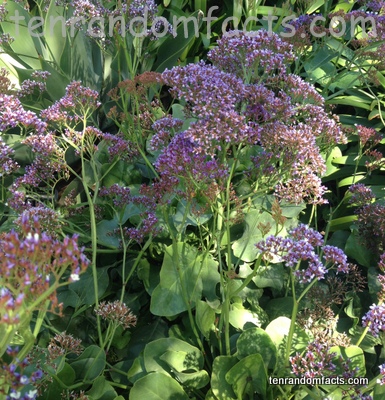Sea-lavenders are just full of variety and colour.
- Sea-lavenders are a genus of at least 150 flowering plants that are either perennial or annual, depending on the species, that are commonly found in salt marshes, and rocky, desert, or coastal habitats.
- ‘Sea-lavender’ is also known as ‘marsh-rosemary’, ‘caspia’, and ‘statice’, although these names may only refer to certain species of the plant.
- The scientific name of sea lavender is Limonium and it is from the family Plumbaginaceae, the family of plumbagos or leadworts.
- Sea-lavenders have native species in all continents except South America and Antarctica, with a high concentration of species in the Mediterranean and west to central Asian regions.
- The sea-lavender genus has an extensive height range of 0.1 to 2 metres (0.3 to 6.6 feet) according to species, however, they are more commonly 0.1 to 0.7 metres (0.3 to 2.3 feet) high.
- The showy calyx surrounding a sea-lavender flower is often considered the ‘flower’, even though technically it isn’t, and it can be coloured purple, pink and violet, as well as the occasional yellow or white; while the actual flower is generally small and often white in colour.
- The leaves of sea-lavenders usually grow at the base of the plant and are generally of a leathery texture, and depending on the species, range from 1 to 30 centimetres (0.4 to 11.8 inches) in length.
- Sea-lavender flowers usually sit in clusters on tall stems above the leaves, and typically bloom in summer, however some early bloomers can be found in spring, while others can be found flowering in autumn.
- Some species of sea-lavender are used decoratively in gardens or for other landscaping purposes, and they are often used as cut flowers or dried flowers, due to the long lasting and colourful papery calyx.
- The scientific name of sea-lavenders, ‘Limonium’, comes from Latin, which originally came from the Ancient Greek word for ‘meadow’, ‘leimōn’.
Bibliography:
Genus Limonium, n.d, PlantNET, http://plantnet.rbgsyd.nsw.gov.au/cgi-bin/NSWfl.pl?page=nswfl&lvl=gn&name=Limonium
Limonium, 2016, Wikipedia, https://en.wikipedia.org/wiki/Limonium
McKinley B & Wright B, Limonium, statice, caspia, 2007, My Teleflora, https://www.myteleflora.com/uploadedFiles/Contents/Design_Education/Floral_Publication_Collection/Flowers-And_Article_Archive/Limonium-June%2007.pdf
Plant Profile: Limonium, 2014, Gardening Australia, http://www.abc.net.au/gardening/stories/s1866714.htm






